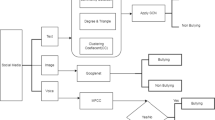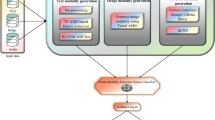Abstract
Aggressive comments containing offensive images and inappropriate gesture signs together with textual comments have grown exponentially in the recent past on social media. These aggressive contents on social media are affecting the victims negatively causing fear, stress, sleeping problems and even suicide in some cases. Since social media contents are unmoderated, a technical solution with the characteristic of having automatic flagging of these contents considering the text and images together is highly needed. This article presents a deep learning and binary firefly-based optimization-based model to classify the social media posts into high-aggressive, medium-aggressive, and non-aggressive classes. The proposed model considers both text and images together to evaluate the aggression level of a post. In this model, the image features of the posts are extracted using pre-trained VGG-16 model, whereas the textual features are extracted using a three-layered convolutional neural network in parallel. The image and text features are then combined to get a hybrid feature set which is further optimized using a binary firefly optimization algorithm. Our proposed model improves the results by 11% in terms of the weighted F1-score with optimized features by binary firefly algorithm over non-optimized features.









Similar content being viewed by others
References
Al-garadi, M.A., Varathan, K.D., Ravana, S.D.: Cybercrime detection in online communications: the experimental case of cyberbullying detection in the Twitter network. Comput. Hum. Behav. 63, 433–443 (2016)
Al-Hassan, A., Al-Dossari, H.: Detection of hate speech in Arabic tweets using deep learning. Multimed Syst. (2021). https://doi.org/10.1007/s00530-020-00742-w
Aroyehun, S.T., Gelbukh, A.: Aggression detection in social media: Using deep neural networks, data augmentation, and pseudo labeling. In: Proceedings of the First Workshop on Trolling, Aggression and Cyberbullying (TRAC-2018), pp. 90–97 (2018)
Arroyo-Fernández, I., Forest, D., Torres-Moreno, J.M., Carrasco-Ruiz, M., Legeleux, T., Joannette, K.: Cyberbullying detection task: the EBSI-LIA-UNAM System (ELU) at COLING’18 TRAC-1. In: Proceedings of the First Workshop on Trolling, Aggression and Cyberbullying (TRAC-2018), pp. 140–149 (2018)
Bhattacharjee, S.D., Tolone, W.J., Paranjape, V.S.: Identifying malicious social media contents using multi-view context-aware active learning. Future Gener. Comput. Syst. 100, 365–379 (2019)
Burnap, P., Williams, M.L.: Cyber hate speech on Twitter: an application of machine classification and statistical modeling for policy and decision making. Policy Internet 7(2), 223–242 (2015)
Chatzakou, D., Kourtellis, N., Blackburn, J., De Cristofaro, E., Stringhini, G., Vakali, A.: Mean birds: Detecting aggression and bullying on Twitter. In: Proceedings of the 2017 ACM on Web Science Conference, pp. 13–22. ACM (2017)
Chen, H., Mckeever, S., Delany, S.J.: Harnessing the power of text mining for the detection of abusive content in social media. In: Advances in Computational Intelligence Systems, pp. 187–205. Springer (2017)
Chen, J., Yan, S., Wong, K.C.: Verbal aggression detection on Twitter comments: convolutional neural network for short-text sentiment analysis. Neural Comput. Appl. 32, 10809–10818 (2020)
Cheng, L., Li, J., Silva, Y.N., Hall, D.L., Liu, H.: Xbully: Cyberbullying detection within a multi-modal context. In: Proceedings of the Twelfth ACM International Conference on Web Search and Data Mining, pp. 339–347. ACM (2019)
Chollet, F.: Xception: deep learning with depthwise separable convolutions. In: Proceedings of the IEEE Conference on Computer Vision and Pattern Recognition, pp. 1251–1258 (2017)
Davidson, T., Warmsley, D., Macy, M., Weber, I.: Automated hate speech detection and the problem of offensive language. In: Eleventh International AAAI Conference on Web and Social Media, pp. 512–515 (2017)
Gallo, F.R., Simari, G.I., Martinez, M.V., Falappa, M.A.: Predicting user reactions to Twitter feed content based on personality type and social cues. Future Gener. Comput. Syst. (2019). https://doi.org/10.1016/j.future.2019.10.044
He, K., Zhang, X., Ren, S., Sun, J.: Deep residual learning for image recognition. In: Proceedings of the IEEE Conference on Computer Vision and Pattern Recognition, pp. 770–778 (2016)
Hosseinmardi, H., Rafiq, R.I., Han, R., Lv, Q., Mishra, S.: Prediction of cyberbullying incidents in a media-based social network. In: 2016 IEEE/ACM International Conference on Advances in Social Networks Analysis and Mining (ASONAM), pp. 186–192. IEEE (2016)
Ibrahim, R.A., Ewees, A.A., Oliva, D., Abd Elaziz, M., Lu, S.: Improved salp swarm algorithm based on particle swarm optimization for feature selection. J. Ambient Intell. Humaniz. Comput. 10(8), 3155–3169 (2019)
Ioffe, S., Szegedy, C.: Batch normalization: Accelerating deep network training by reducing internal covariate shift. arXiv preprint arXiv:1502.03167 (2015)
Khanesar, M.A., Teshnehlab, M., Shoorehdeli, M.A.: A novel binary particle swarm optimization. In: 2007 Mediterranean Conference on Control & Automation, pp. 1–6. IEEE (2007)
Kornblum, J.: Cyberbullying grows bigger and meaner with photos, video, USA Today, dated July 17, 2008. https://cybercrimes.wordpress.com/2008/07/17/cyberbullying-grows-bigger-and-meaner-with-photos-video/
Kumar, A., Sachdeva, N.: Multi-input integrative learning using deep neural networks and transfer learning for cyberbullying detection in real-time code-mix data. Multimedia Syst. (2020). https://doi.org/10.1007/s00530-020-00672-7
Kumar, A., Sachdeva, N.: Multimodal cyberbullying detection using capsule network with dynamic routing and deep convolutional neural network. Multimedia Syst. (2021). https://doi.org/10.1007/s00530-020-00747-5
Kumari, K., Singh, J.P.: AI_ML_NIT Patna at HASOC 2019: deep learning approach for identification of abusive content. In: Proceedings of the 11th Annual Meeting of the Forum for Information Retrieval Evaluation, December 2019, pp. 328–335 (2019)
Kumari, K., Singh, J.P.: Identification of cyberbullying on multi-modal social media posts using genetic algorithm. Trans. Emerg. Telecommun. Technol. 32(2), e3907 (2021)
Kumari, K., Singh, J.P., Dwivedi, Y.K., Rana, N.P.: Aggressive social media post detection system containing symbolic images. In: Conference on e-Business, e-Services and e-Society, pp. 415–424. Springer (2019)
Kumari, K., Singh, J.P., Dwivedi, Y.K., Rana, N.P.: Towards cyberbullying-free social media in smart cities: a unified multi-modal approach. Soft Comput. 24(15), 11059–11070 (2020)
Kumari, K., Singh, J.P., Dwivedi, Y.K., Rana, N.P.: Multi-modal aggression identification using convolutional neural network and binary particle swarm optimization. Future Gener. Comput. Syst. 118, 187–197 (2021)
Marie-Sainte, S.L., Alalyani, N.: Firefly algorithm based feature selection for Arabic text classification. J. King Saud Univ. Comput. Inf. Sci. 32(3), 320–328 (2020)
Modha, S., Majumder, P., Mandl, T.: Filtering aggression from the multilingual social media feed. In: Proceedings of the First Workshop on Trolling, Aggression and Cyberbullying (TRAC-2018), pp. 199–207 (2018)
Nikhil, N., Pahwa, R., Nirala, M.K., Khilnani, R.: LSTMs with attention for aggression detection. In: Proceedings of the First Workshop on Trolling, Aggression and Cyberbullying (TRAC-2018), pp. 52–57 (2018)
Pater, J.A., Miller, A.D., Mynatt, E.D.: This digital life: A neighborhood-based study of adolescents’ lives online. In: Proceedings of the 33rd Annual ACM Conference on Human Factors in Computing Systems, pp. 2305–2314. ACM (2015)
Paul, S., Saha, S.: CyberBERT: BERT for cyberbullying identification. Multimedia Syst. (2020). https://doi.org/10.1007/s00530-020-00710-4
Pennington, J., Socher, R., Manning, C.: Glove: Global vectors for word representation. In: Proceedings of the 2014 Conference on Empirical Methods in Natural Language Processing (EMNLP), pp. 1532–1543 (2014)
Raiyani, K., Gonçalves, T., Quaresma, P., Nogueira, V.B.: Fully connected neural network with advance preprocessor to identify aggression over Facebook and Twitter. In: Proceedings of the First Workshop on Trolling, Aggression and Cyberbullying (TRAC-2018), pp. 28–41 (2018)
Risch, J., Krestel, R.: Aggression identification using deep learning and data augmentation. In: Proceedings of the First Workshop on Trolling, Aggression and Cyberbullying (TRAC-2018), pp. 150–158 (2018)
Salawu, S., He, Y., Lumsden, J.: Approaches to automated detection of cyberbullying: a survey. IEEE Trans. Affect. Comput. 11(1), 3–24 (2020)
Samghabadi, N.S., Mave, D., Kar, S., Solorio, T.: RiTUAL-UH at TRAC 2018 Shared Task: Aggression identification. In: Proceedings of the First Workshop on Trolling, Aggression and Cyberbullying (TRAC-2018), pp. 12–18 (2018)
Sangwan, S., Bhatia, M.: D-BullyRumbler: a safety rumble strip to resolve online denigration bullying using a hybrid filter-wrapper approach. Multimedia Syst. (2020). https://doi.org/10.1007/s00530-020-00661-w
Selvakumar, B., Muneeswaran, K.: Firefly algorithm based feature selection for network intrusion detection. Comput. Secur. 81, 148–155 (2019)
Simonyan, K., Zisserman, A.: Very deep convolutional networks for large-scale image recognition. arXiv preprint arXiv:1409.1556 (2014)
Singh, J.P., Dwivedi, Y.K., Rana, N.P., Kumar, A., Kapoor, K.K.: Event classification and location prediction from tweets during disasters. Ann. Oper. Res. 283, 737–757 (2019)
Singh, V.K., Ghosh, S., Jose, C.: Toward multimodal cyberbullying detection. In: Proceedings of the 2017 CHI Conference Extended Abstracts on Human Factors in Computing Systems, pp. 2090–2099. ACM (2017)
Srivastava, S., Khurana, P., Tewari, V.: Identifying aggression and toxicity in comments using capsule network. In: Proceedings of the First Workshop on Trolling, Aggression and Cyberbullying (TRAC-2018), pp. 98–105 (2018)
Tommasel, A., Rodriguez, J.M., Godoy, D.: Textual aggression detection through deep learning. In: Proceedings of the First Workshop on Trolling, Aggression and Cyberbullying (TRAC-2018), pp. 177–187 (2018)
Tripathy, J.K., Chakkaravarthy, S.S., Satapathy, S.C., Sahoo, M., Vaidehi, V.: ALBERT-based fine-tuning model for cyberbullying analysis. Multimed. Syst. 1–9 (2020)
Wang, X., Yang, J., Teng, X., Xia, W., Jensen, R.: Feature selection based on rough sets and particle swarm optimization. Pattern Recognit. Lett. 28(4), 459–471 (2007)
Waseem, Z., Hovy, D.: Hateful symbols or hateful people? predictive features for hate speech detection on Twitter. In: Proceedings of the NAACL Student Research Workshop, pp. 88–93 (2016)
Wu, J., Wen, M., Lu, R., et al.: Toward efficient and effective bullying detection in online social network. Peer-to-Peer Netw. Appl. 13, 1567–1576 (2020)
Xue, B., Zhang, M., Browne, W.N.: Particle swarm optimization for feature selection in classification: a multi-objective approach. IEEE Trans. Cybern. 43(6), 1656–1671 (2012)
Zhang, L., Shan, L., Wang, J.: Optimal feature selection using distance-based discrete firefly algorithm with mutual information criterion. Neural Comput. Appl. 28(9), 2795–2808 (2017)
Zhang, Y., Song, X.F., Gong, D.W.: A return-cost-based binary firefly algorithm for feature selection. Inf. Sci. 418, 561–574 (2017)
Zhao, R., Mao, K.: Cyberbullying detection based on semantic-enhanced marginalized denoising auto-encoder. IEEE Trans. Affect. Comput. 8(3), 328–339 (2017)
Author information
Authors and Affiliations
Corresponding author
Additional information
Publisher's Note
Springer Nature remains neutral with regard to jurisdictional claims in published maps and institutional affiliations.
Rights and permissions
About this article
Cite this article
Kumari, K., Singh, J.P. Multi-modal cyber-aggression detection with feature optimization by firefly algorithm. Multimedia Systems 28, 1951–1962 (2022). https://doi.org/10.1007/s00530-021-00785-7
Received:
Accepted:
Published:
Issue Date:
DOI: https://doi.org/10.1007/s00530-021-00785-7




